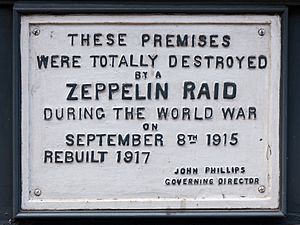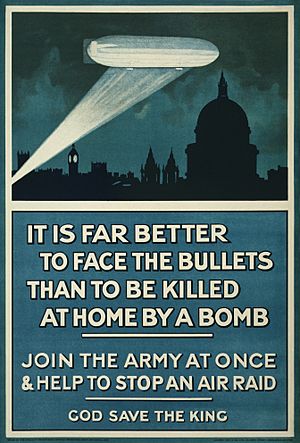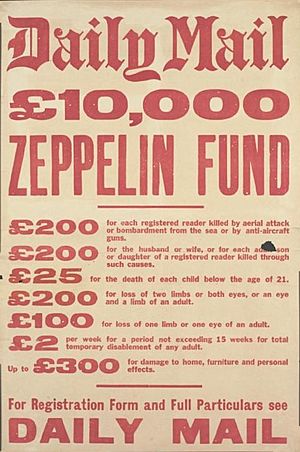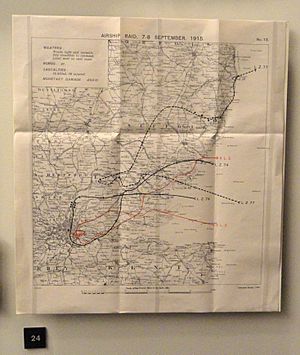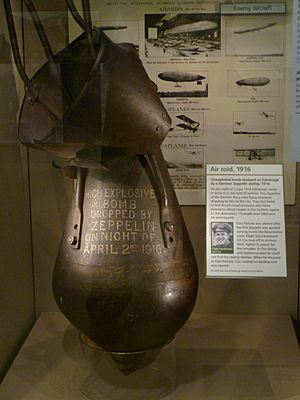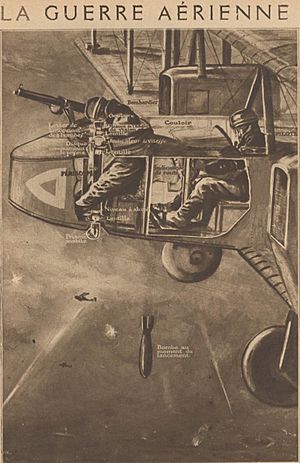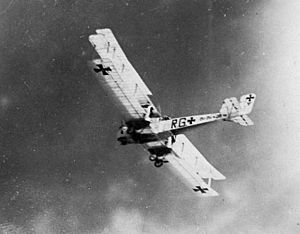German bombing of Britain, 1914–1918 facts for kids
During World War I, Germany launched many air attacks on Britain. These attacks mostly used large airships called Zeppelins, though other types like Schütte-Lanz were also used. People in Britain often called them 'Zeppelin raids.' These raids started in January 1915 and continued until the war ended in November 1918. Both the German Navy's air department and the Imperial German Flying Corps carried out over 50 bombing missions.
Flying airships at night and in bad weather made it hard to navigate and bomb targets accurately. Bombs often landed far from their intended military targets, sometimes hitting towns instead. Many civilians were hurt or killed, which made the Zeppelins very unpopular. As Britain improved its defenses, airship raids became much more dangerous for the Germans. By 1917, airplanes largely replaced airships for these attacks.
The raids didn't have a huge military impact. But they caused a lot of fear, disrupted factories a bit, and made Britain move important resources away from the main battlefields in France. Because of concerns about how Britain was defending itself, a special inquiry was held. This led to the creation of the Royal Air Force (RAF) on April 1, 1918.
During the war, German airships made 51 bombing raids on Britain. These raids killed 557 people and injured 1,358. They dropped 5,806 bombs, causing about £1.5 million in damage. Out of 84 airships used, 30 were shot down or lost in accidents. Airplanes carried out 52 raids, dropping 2,772 bombs. These airplane raids killed 857 people, injured 2,058, and caused about £1.4 million in damage. Some people call these German bombings the first "Blitz," a term later used for the heavy bombing of Britain in World War II. The defense system Britain developed also helped prepare for how they would defend against air attacks in the Second World War.
Contents
Early Air Attacks (1914)
First German Bombings
On August 6, 1914, a German Army Zeppelin called Z VI bombed the Belgian city of Liège, killing nine civilians. More people died in attacks on Antwerp later that month. Germany also created a special air unit, secretly called the "Ostend Carrier Pigeon Detachment," to bomb ports along the English Channel.
In the first months of the war, a German pilot flying a plane called an Etrich Taube regularly dropped bombs on Paris. The first raid included five small bombs and a note demanding that Paris surrender. Before the fighting on the Western Front settled down, German planes bombed Paris several times, even slightly damaging Notre Dame Cathedral. The very first bombing raids on England were small attacks on Channel ports.
First Attack on Britain
The first confirmed air raid on Britain happened on December 21, 1914. A German seaplane dropped two bombs into the sea near the Admiralty Pier in Dover. On December 24, the same pilot dropped a bomb in Dover that exploded in a garden, injuring a man picking Brussels sprouts for Christmas dinner! Windows in nearby houses broke, and another neighbor was knocked off a ladder. Another bomb landed near Dover Castle, breaking some glass. A British pilot tried to find the German plane but couldn't.
On Christmas Day, the same German seaplane flew over Sheerness. Anti-aircraft guns fired at it as it flew up the River Thames. Three British planes chased it. A British plane called a Vickers F.B.4 caught up near Erith. The Vickers plane's machine gun jammed, so the gunner used a rifle loaded with special bullets meant for airships. He hit the German plane three times. The German pilot quickly dived away, and the British plane had engine trouble and had to land. On its way back to sea, the German plane dropped two more bombs harmlessly.
German Bombing Plans (1915)
Starting the Airship Campaign
German naval officers first suggested bombing Britain in August 1914. The German Kaiser approved the campaign on January 7, 1915. At first, he didn't want London bombed because his relatives were in the British royal family.
The first successful airship raid happened on the night of January 19-20, 1915. Two Zeppelins were supposed to bomb targets near the Humber River, but strong winds blew them off course. They ended up dropping bombs on Great Yarmouth, Sheringham, King's Lynn, and nearby villages in Norfolk. Four people were killed and 16 injured.
This raid caused rumors that German spies were using car headlights to guide the Zeppelins. Early attempts by the German Navy to bomb London failed due to bad weather. One Zeppelin was shot at by Belgian troops and destroyed by strong winds after landing. Other raids were canceled or failed because of fog or mechanical problems. It was decided to wait for newer, more capable Zeppelins to be ready.
The German Army received the first of these new Zeppelins, LZ38. It raided Ipswich and Southend in April and May. On May 5, 1915, the Kaiser officially allowed bombing targets in eastern London. LZ38 also attacked Dover and Ramsgate. Over Dover, it was caught in searchlights for the first time in the war. British anti-aircraft fire made the pilot drop his bombs early. A Canadian pilot flying a British plane tried to attack LZ38 but couldn't catch it. LZ38 attacked Southend again, killing three people. British planes tried to intercept it but failed because the Zeppelin was flying too high.
First London Raid
On the night of May 30-31, LZ38 made the first raid on London. It crossed the English coast near Margate and flew west over Southend. London police were warned, and soon small incendiary bombs (bombs designed to start fires) began to fall. These bombs, weighing about 25 pounds, were filled with a chemical called thermite and wrapped in tarred rope. About 120 bombs were dropped across parts of London. Seven people were killed and 35 injured, and 41 fires started. The government then told newspapers not to report details about where bombs had fallen, as earlier reports had helped the Germans with navigation. Fifteen British planes flew to intercept the Zeppelin, but only one saw it. No ground guns or searchlights found the airship.
Naval airships also tried to raid London. On June 4, strong winds caused one airship to bomb Gravesend by mistake. Another, L9, was blown off course and attacked Hull instead of London, causing a lot of damage. On the same night, three Army Zeppelins failed their raid due to weather. As they returned to Belgium, British planes from Veurne attacked them. LZ38 was destroyed on the ground. LZ37 was attacked in the air by Reginald Warneford, who dropped bombs on it, setting it on fire. LZ37 crashed into a convent school, killing two nuns and almost all the Zeppelin's crew. Warneford received the Victoria Cross for this brave act. After this, Zeppelins were moved away from their bases in Belgium.
After a few more raids, the short summer nights made further attacks difficult for a few months. The Navy resumed raids in August. On August 9-10, four Zeppelins tried to reach London, but none did. One, L12, was damaged by ground fire and crashed into the sea. Another raid on August 12-13 also failed to reach London. On August 17-18, L10 became the first Navy airship to reach London. However, it made navigation mistakes, bombing Walthamstow and Leytonstone instead of military targets. Ten people were killed, 48 injured. L10 was destroyed two weeks later when lightning struck it.
On September 7-8, two Army Zeppelins bombed London. Eighteen people were killed and 28 injured. These raids didn't have a big military effect, but they caused a lot of fear. The Navy tried to follow up the next night. L13 and L14 flew across the North Sea. L14 was spotted by trawlers (fishing boats) and fired upon, making it climb higher and turn away. L13 flew straight to London in clear skies. It dropped a very large 660-pound bomb near Smithfield Market, destroying houses and killing two men. More bombs fell on textile warehouses, causing a huge fire that needed 22 fire engines to put out. This fire alone caused over half a million pounds in damage. L13 was caught by searchlights and fired upon by 26 anti-aircraft guns, but it wasn't hit. This raid killed 22 people and injured 87. The damage was enormous, over one-sixth of all damage from bombing raids during the entire war.
The Theatreland Raid
After a few more raids were stopped by bad weather, five Zeppelins launched a large attack on October 13, known as the Theatreland Raid. As they neared London, they faced new defenses, including new 3-inch guns. These guns didn't stop the Zeppelins, but the airship commanders noticed the improved defenses. L15 bombed near Charing Cross, hitting the Lyceum Theatre and killing 17 people. More bombs fell on Holborn. L15 was hit by a new French 75mm anti-aircraft gun mounted on a truck. It quickly dropped its remaining bombs and left, with engine damage. Other Zeppelins bombed different areas, including Otterpool Army Camp near Folkestone, killing 14 soldiers. In total, 71 people were killed and 128 injured in this raid. This was the last raid of 1915, as bad weather continued into early 1916.
By December 1915, Germany had new and larger Zeppelins. However, Britain's improved defenses made raids more dangerous. By mid-1916, England had 271 anti-aircraft guns and 258 searchlights. New types of Zeppelins could fly higher, but this caused new problems like extreme cold for the crew and navigation difficulties. British defenses were divided between the Navy and the Army's Royal Flying Corps (RFC). At first, Britain didn't use incendiary (fire-starting) bullets, thinking they wouldn't work against Zeppelins. But later experiments showed that a mix of explosive and incendiary bullets was very effective. These new bullets gave British planes their first victories.
Air Attacks Continue (1916)
The first raid of 1916 happened on the night of January 31/February 1. Nine German Navy Zeppelins were sent to Liverpool. But bad weather and navigation problems scattered them across the "Black Country" region, bombing towns like Tipton and Walsall. Sixty-one people were killed and 101 injured. Despite thick fog, 22 British planes took off but couldn't find the Zeppelins. Six planes were badly damaged, and two pilots died in landing accidents.
One Zeppelin, L19, was last seen in trouble near the West Frisian Islands. A British trawler (fishing boat) captain later reported seeing L19 sinking in the sea. The Zeppelin crew asked for rescue, but the trawler captain refused, fearing his small crew would be overpowered by the Germans. A search found nothing.
By February 1916, Britain had ten home defense squadrons. London's defense was given to 39 (Home Defence) Squadron, equipped with B.E.2c aircraft. These planes were outdated for fighting on the Western Front, but they were stable for night flying. Raids were delayed due to bad weather and mechanical problems with many Navy Zeppelins. On March 5-6, three Zeppelins tried to bomb Rosyth but were blown off course to Hull, killing 18 people.
On March 19, German seaplanes bombed Dover, hitting forts and barracks. On the night of March 30/April 1, ten Zeppelins set out to bomb eastern England and London. Most turned back due to problems. L15 was damaged by anti-aircraft fire and then attacked by Alfred Brandon using special "Ranken darts." It crashed into the sea near Margate. Most of the 48 people killed in this raid died when a bomb hit an Army building in Cleethorpes.
On April 2-3, six airships raided. Naval airships aimed for a naval base in Scotland, and Army Zeppelins attacked London. None hit their intended targets. Thirteen people were killed, and much damage was caused by a warehouse full of whisky being destroyed in Leith. Other raids in early April had little effect.
On July 28-29, the first raid included L31, one of the new, larger R-class Zeppelins. These were 200 meters long, could fly at 13,000 feet, and carry up to 4 tons of bombs. But the ten Zeppelins in this raid achieved very little due to fog. On August 24-25, L31 reached London, flying above low clouds. It dropped 36 bombs on various areas, killing nine people and injuring 40. L31 was not damaged in the attack.
On September 2-3, twelve Navy airships and four Army airships attacked England. Rain and snowstorms scattered them. Only one Army airship and a new SL11 reached their targets. SL11 came over Foulness to attack London from the north-west. It was caught by searchlights and fired upon. Around 2:15 a.m., a British pilot named Lieutenant William Leefe Robinson in a B.E.2c plane attacked SL11. He fired three bursts of ammunition, and the airship quickly caught fire and fell to the ground near Cuffley. There were no survivors. For this victory, Leefe Robinson received the Victoria Cross. The parts of SL11 were collected and sold by the Red Cross to raise money for wounded soldiers.
The loss of SL11 made the Army stop its raids on Britain. But the Navy continued. On September 23-24, a 12-Zeppelin raid was launched. Eight older airships bombed targets in the Midlands and North-east. Four new M-class Zeppelins attacked London. L31 dropped bombs on Streatham, killing seven people, and then on Leyton, killing another eight. L32 was delayed by engine problems and dropped bombs on Aveley and South Ockendon. At 1:10 a.m., a B.E.2c piloted by 2nd Lieutenant Frederick Sowrey attacked L32. He fired incendiary ammunition, setting the Zeppelin on fire. L32 crashed, killing all 22 crew members. Some chose to jump rather than burn.
L33 dropped bombs on Upminster and Bromley. It was hit by an anti-aircraft shell, even though it was at 13,000 feet. It dropped more bombs to lose weight and continued to lose height. L33 was forced to land in a field near Little Wigborough. The crew set the airship on fire and were later arrested by police. Inspecting the wreckage gave Britain a lot of information about how Zeppelins were built, which helped them design their own airships.
The next raid was on October 1, 1916. Eleven Zeppelins were launched, but only L31, commanded by Heinrich Mathy, reached London. L31 was caught by searchlights. Three British planes closed in. A B.E.2c piloted by 2nd Lieutenant Wulstan Tempest attacked L31. Three bursts of fire were enough to set L31 on fire, and it crashed near Potters Bar, killing all 19 crew members. Mathy jumped to his death.
On November 27-28, a large raid by ten Zeppelins avoided London and attacked targets in the Midlands and Tyneside. The bombing was mostly ineffective, killing four people. L34 was shot down in flames off Hartlepool by 2nd Lieutenant Ian Pyott. L21 was shot down near Yarmouth by three planes. The next day, a German airplane made the first German airplane raid on London, dropping bombs near Victoria station.
There were no more raids in 1916. Germany lost three more airships in accidents in December. German losses led them to try to make airships less vulnerable by making them fly higher. Zeppelins were made lighter, sometimes by removing an engine, allowing them to fly over 16,000 feet. Germany also started planning a daylight bombing attack on Britain using airplanes, called Operation Turk's Cross.
Air Attacks Continue (1917)
The German bomber squadron for Operation Turk's Cross, called Kagohl 3, received its first Gotha Bomber planes in March 1917. These planes were based in Belgium.
The first Zeppelin raid of 1917 on March 16-17 faced very strong winds, and none reached their targets. On the way back, L39 had engine trouble, was blown over French territory, and was shot down by ground fire. All the crew were killed. On May 23-24, six Zeppelins tried to bomb London but were stopped by high winds and thick clouds.
German bombing raids on June 13, using both Gotha bombers and airships, made the British population very angry. This raid caused 527 casualties, including 104 deaths, many of them children. A bomb hitting a children's school and killing students led to a plaque with a poem about the tragedy.
Operation Turk's Cross (Daylight Raids)
Operation Turk's Cross began on May 25, 1917, at 2:00 p.m. Twelve Gotha bombers set out to bomb London, but two turned back with mechanical problems. The remaining ten bombers were seen making landfall around 5:00 p.m. Clouds over London made the Gothas change their target to the Channel port of Folkestone and the nearby Shorncliffe Army Camp.
At Shorncliffe, 17 Canadian soldiers were killed and 93 wounded. In Folkestone, 95 people were killed and 195 injured, mostly shoppers on Tontine Street. As the planes flew out to sea, they were chased by 33 RFC and 37 RNAS aircraft. Many British planes couldn't climb high enough to reach the Gothas. One British pilot attacked a Gotha but his gun jammed. Another pilot attacked a Gotha, seeing smoke from its engine, but was then attacked by another Gotha. German records later showed that some Gothas were shot down or crashed.
An attack on June 5 was diverted due to bad weather. But a third raid on June 13, taking off at 10:00 a.m., was the first daylight raid on London. British defenses were not ready for this. Ninety-two British planes took off, but few could climb high enough. One British plane's observer was killed by return fire from a Gotha. Another British plane was hit by anti-aircraft guns and had to land. As the Gothas flew on, they saw planes taking off from airfields and smoke from anti-aircraft fire.
This raid caused 162 deaths and 432 injuries. Among the dead were 18 children killed by a bomb falling on the Upper North Street School in Poplar. Many people were in the streets watching the raid because they didn't realize how dangerous it was. This was the deadliest air raid of the war, and no Gothas were lost. News of the raid was celebrated in Germany, and the commander, Brandenburg, received Germany's highest military honor.
On the night of June 16-17, six Zeppelins attempted a raid. Two couldn't leave their sheds, and two turned back. Of the two that reached England, L42 hit a naval ammunition store. L48, a new U-class Zeppelin, was intercepted near Harwich and attacked by three British planes. The Zeppelin crashed in flames near Theberton in Suffolk.
A further Gotha raid of 22 aircraft on July 7 resulted in 57 deaths and 193 injuries. One Gotha was shot down, and three were damaged. Felixstowe and Harwich were bombed on July 22, and Southend and Shoeburyness on August 12, with one Gotha lost. On August 18, the largest raid of the war was attempted, with 28 aircraft. But strong winds blew them far off course. With little fuel left, the attack was called off. Two planes crashed into the North Sea, and others ran out of fuel, with two landing in neutral Holland. On August 22, 15 aircraft set out to attack Margate and Dover. They were met by heavy anti-aircraft fire and fighter planes. Two Gothas were shot down immediately, and a third over Dover.
Night Bombing Begins
Improved British air defenses forced the German Kagohl 3 squadron to switch to night bombing. This was meant to be temporary, but even newer Gotha models didn't improve much. Night raids offered some protection from fighter planes and anti-aircraft fire, but they made navigation and landing much harder. Many damaged planes crashed when trying to land back at their airfields.
The first night attack was an experimental raid by five Gothas on September 3-4 against Chatham. The weather was good. Bombs fell on farms and houses. A 12 kg bomb fell on Chatham, and two hit a drill hall being used as accommodation for sailors. These explosions killed 130 sailors and wounded 88. Other bombs caused minor damage. None of the local anti-aircraft guns fired, as the bombers were invisible in the dark. The bombing of the RNAS barracks caused the worst death toll of the war.
Encouraged by the lack of night defenses, a raid on London happened the following night. Nine of eleven aircraft reached England, and five reached London. Eighteen British defensive flights were made, but none found the bombers. These flights were important because they showed that Sopwith Camels could fly at night. One Gotha was lost, likely shot down by anti-aircraft fire. Six more raids followed at the end of September. These included the first raids on England by the huge German "Riesenflugzeuge" (Giant airplanes).
On September 24, 16 Gothas set out, with 13 reaching England. Most bombed Dover and other targets in Kent, with only five reaching London. The next night, 15 Gothas set out with similar results. One bomber crashed into the North Sea. On September 28, 25 Gothas and two Giants took off, but most turned back due to bad weather. Three people were wounded, and three Gothas were lost.
The following night, seven Gothas and three Giants took off, killing 40 people and injuring 87. By this time, Londoners were very scared. Up to 300,000 people sought shelter in Underground stations, and others left London to sleep in fields. On September 30 and October 1, more Gotha raids happened. British anti-aircraft guns fired over 14,000 rounds without hitting anything. Shells were running low, and many gun barrels were worn out. The government moved new 3-inch guns from merchant ships to defend London. The falling shell fragments from the anti-aircraft guns were also dangerous, killing eight people and injuring 67 in one week.
The 'Silent' Zeppelin Raid (1917)
The last Zeppelin attack on London happened on the night of October 19, 1917. It had been over a year since the last Zeppelin raid. During this time, German airships could fly much higher, out of reach of existing British planes. Their undersides were also painted a special non-reflective black, making them almost invisible to searchlights. Up to eleven Zeppelins approached London from the north.
The commander of London's air defenses, Lt-Col. Alfred Rawlinson, guessed that the airships might turn off their engines and drift silently over London. He ordered all searchlights in London to be turned off so they wouldn't give away the Zeppelins' position. A bomb was dropped around 11:30 p.m. on Piccadilly Circus, destroying a store, but the ground defenses remained silent. Another bomb fell a few minutes later. The trick worked; London avoided up to 200 bombs. None of the Zeppelins made it back to their base. Blown by a strong gale, some were shot down by French anti-aircraft guns or forced to land in France. Three more were carried out to sea and lost.
More Gotha Raids
The British RNAS and RFC bombed German bomber airfields, forcing the squadrons to move. The next raid on England was on October 29, with three aircraft. The following night, a big raid with 22 Gothas took place. They carried many new 10-pound incendiary bombs. Over half dropped their bombs on Kent, destroying a gasometer in Ramsgate. Bombs also fell on London's eastern suburbs, but many incendiaries failed to ignite. Five aircraft crashed while landing.
Bad weather prevented raids in November. On December 5, 19 Gothas and two Giants attacked in waves. Casualties were light, but over £100,000 in damage was caused, mostly in London. Two Gothas were shot down by anti-aircraft fire, and one crashed while landing.
Air Attacks in 1918
On January 28, 1918, 13 Gothas and two Giants took off into a clear sky, but thick mist spread. Six Gothas turned back. Over a hundred British night-fighter flights were made. One Gotha was shot down by two British Camels, the first victory for night-fighters against a bomber over Britain. Both pilots received the Distinguished Flying Cross.
The bombing killed 67 people and injured 166. Many casualties were caused by a 300 kg bomb that hit a printing works being used as a shelter. After these losses, German operations against England were stopped to reorganize and replace aircraft and crews.
The following night, the first raid by Giants alone took place. Four aircraft took off, each with a 1000 kg bomb load. One turned back. The other three crossed the English coast. Observers mistakenly thought there were at least fifteen aircraft, and eighty fighters were scrambled. One Giant was forced to turn back by anti-aircraft fire. Another Giant approaching London was attacked by a British plane, and both aircraft hit each other. The Giant bombed Isleworth, Kew, and Brentford, killing ten people. Another Giant was attacked by British pilots but flew on despite the attacks.
Rfa 501 attacked again on February 16-17. One Giant carried a 1000 kg bomb that fell near Victoria station, hitting the Royal Hospital, Chelsea. Another aircraft attacked the following night, hitting St Pancras station, killing 21 people. Another Giant raid on March 7 killed 21 people, including Lena Ford, who wrote the song Keep the Home Fires Burning.
On March 12, five Zeppelins tried to raid the Midlands but were blown off course, bombing the Hull area with little effect. Another raid the next night had only one airship reach England, bombing Hartlepool. Eight people were killed. A third airship raid on April 12 caused navigational problems due to high altitude and weather. Most bombs fell in open country. Seven people were killed.
By mid-March, the Gotha squadron was ready to attack England again, but they had to support the German spring offensive. On May 9, Rfa 501 suffered a disaster when four aircraft tried to bomb Dover. High winds forced them to turn back, but fog covered their base. Two crashed, killing almost all their crews.
The last and largest airplane raid of the war happened on the night of May 19, 1918. Thirty-eight Gothas and three Giants attacked London. Six Gothas were shot down by night-fighters and anti-aircraft fire. A seventh was forced to land after a long fight with a British Bristol fighter. This was the first victory for Biggin Hill airfield. The British estimated that 2,700 pounds of bombs were dropped. Forty-nine people were killed, 177 injured.
After this raid, the German bomber squadrons mainly supported the army. Germany had a plan called "The Fire Plan" to use all their heavy bombers to drop incendiary bombs on London and Paris in waves, hoping to cause huge fires and force the Allies to surrender. Thousands of these bombs were delivered, and the operation was planned for August and early September 1918. But both times, the order to take off was canceled at the last moment, perhaps because Germany feared Allied revenge.
The last Zeppelin raid on Britain took place on August 5, 1918. Four Zeppelins bombed targets in the Midlands and North of England. Two British planes intercepted the new L70, which was carrying Peter Strasser, the leader of the German Imperial Navy's airships. The Zeppelin was shot down in flames with no survivors. Egbert Cadbury and Robert Leckie flying a DH.4 were credited with the victory. The remaining airships dropped their bombs blindly, and none fell on land. The wreckage of L70 was salvaged, giving Britain a lot of technical information. The bodies of the crew were buried at sea.


